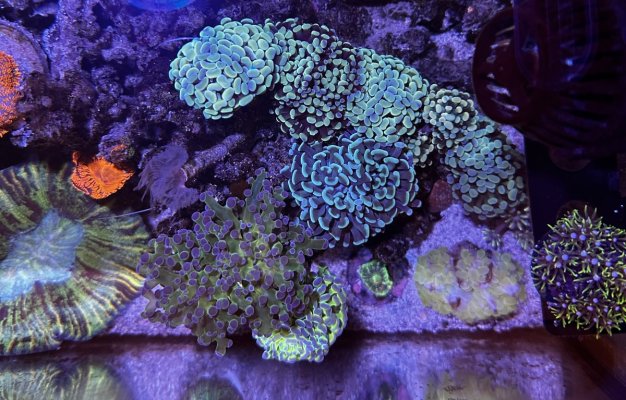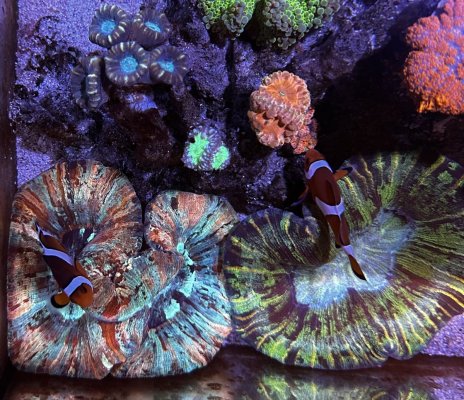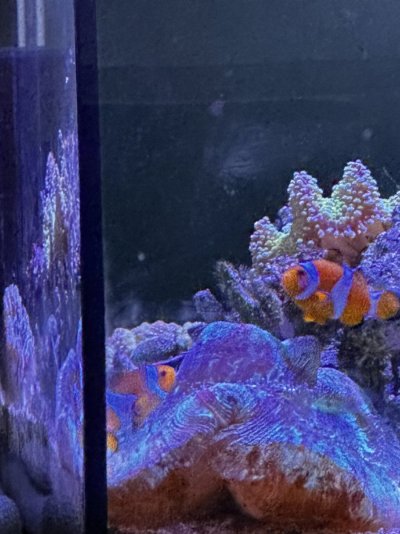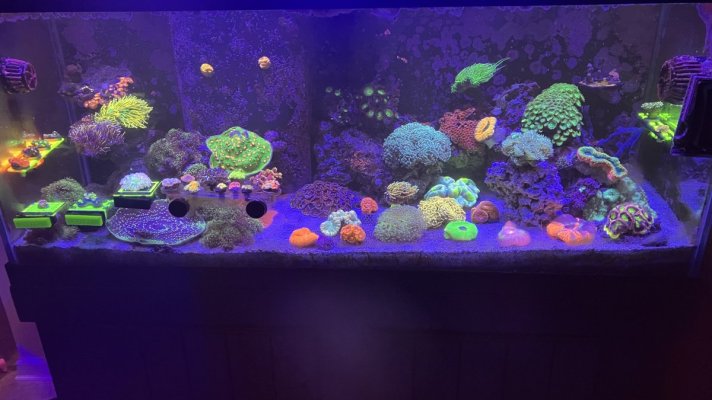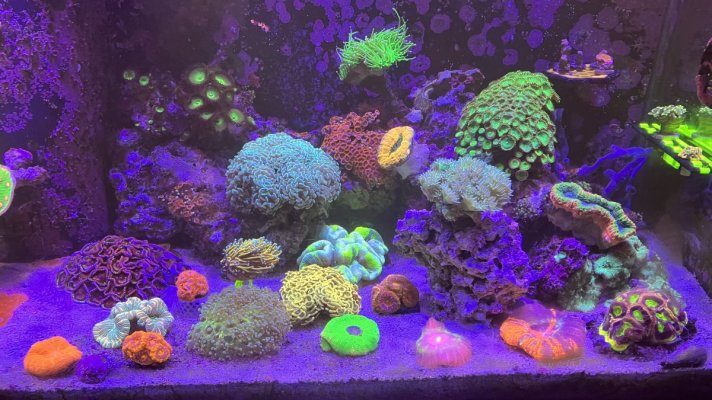Navigation
Install the app
How to install the app on iOS
Follow along with the video below to see how to install our site as a web app on your home screen.
Note: This feature may not be available in some browsers.
More options
You are using an out of date browser. It may not display this or other websites correctly.
You should upgrade or use an alternative browser.
You should upgrade or use an alternative browser.
Lps dominated reef tempertaure
- Thread starter thatindonesianreefer
- Start date
- Tagged users None
I keep my lps dominant mixed reef at 76-78 degrees Fahrenheit . Seems plenty happy . That lower number seems a bit chilly honestly.
Thanks!I keep my lps dominant mixed reef at 76-78 degrees Fahrenheit . Seems plenty happy . That lower number seems a bit chilly honestly.
i cant think
Wrasse Addict
View Badges
Excellence Award
Reef Tank 365
Article Contributor
UK Reef Club Member
Rock Pool Reef Keepers
My Tank Thread
My Aquarium Showcase
I personally run my reef at 24°C and not often higher or lower. It can drop to 23.8 sometimes but it’s uncommon.
I wouldn’t be surprised if LPS could do well in 21-23°C but it’s not recommended. I’d probably aim for 23-25°C with 24 being the best spot.
I am reading this with interest. Why do we keep the tanks colder than normal for a tropical reef? For example, it's Autumn here and the water temperature of the Great Barrier Reef is 29 deg C (about 84 F). Average about 29 dec C in March.
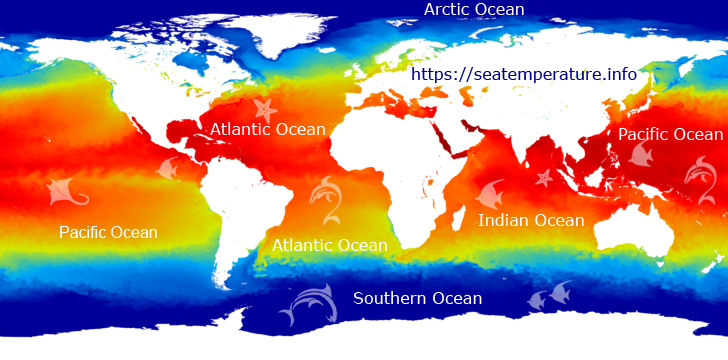
 seatemperature.info
seatemperature.info

Great Barrier Reef ocean water temperature today | QLD, Australia
Sea water temperature forecast and historical data for Great Barrier Reef. Today's ocean surface temperature report. Average monthly ocean temperature
My assumption is the reccomended range is found to be something suitable for corals and fish from all the commonly collected areas of the world. Australia, Fiji, indonesia, Africa etc.
some might get warmer and cooler at different times of the year but all should be 78 sometimes and not cause issues
Total disclosure - I made this completely up. But, it makes sense. I could be completely wrong too
some might get warmer and cooler at different times of the year but all should be 78 sometimes and not cause issues
Total disclosure - I made this completely up. But, it makes sense. I could be completely wrong too
My assumption is the reccomended range is found to be something suitable for corals and fish from all the commonly collected areas of the world. Australia, Fiji, indonesia, Africa etc.
some might get warmer and cooler at different times of the year but all should be 78 sometimes and not cause issues
Total disclosure - I made this completely up. But, it makes sense. I could be completely wrong too
Well, my tanks have always peaked at about 29 deg C in Summer, and I set my heater to at least 25 for Winter (that's 77 to 84 fahrenheit). That pretty much simulates what is going on in the real world outside on the actual reef, and most of the coral sold here is local I suspect. As you can see 78 is at the lower end of that.
btw. I have spoken with people living in places like Darwin. One guy told me he had a tank on his patio with no heaters and no articial lighting, just daylight. Wouldn't that be nice
- Joined
- Jun 28, 2020
- Messages
- 5,323
- Reaction score
- 9,455
There was an article that discussed coral metabolism and temp. It depends on where the corals evolved, but the drop in metabolism was significant, like 10% slower for a degree or 2. So if you run a tank at 10 degrees f less, the coral is not thriving, but 'operating' at 50% efficiency, maybe barely surviving.
As the temps warm up, bacteria growth is sped up,both good and bad types.
You could run the experiment and lower the tank temp a degree at a time, monitoring for adverse effects.
Let us know your results.
70-71°F seems too low.
Ideal temperature really depends on what you keep and their collection locality. Seeing that you live in Indonesia, most of the corals you get are likely collected locally, so they would prefer temperatures of ~77°F. If you were to have corals collected from higher latitudes, such as Australian Scolies (Homophyllia australis or cf Micromussa pacifica), Micromussa lordhowensis, Homophyllia bowerbanki, Paragoniastrea australensis, or Australophyllia wilsoni, then you would want cooler temperatures for your tank.
Ideal temperature really depends on what you keep and their collection locality. Seeing that you live in Indonesia, most of the corals you get are likely collected locally, so they would prefer temperatures of ~77°F. If you were to have corals collected from higher latitudes, such as Australian Scolies (Homophyllia australis or cf Micromussa pacifica), Micromussa lordhowensis, Homophyllia bowerbanki, Paragoniastrea australensis, or Australophyllia wilsoni, then you would want cooler temperatures for your tank.
That’s pretty chilly.
I keep my LPS dominated reef between 76 and 77 using an Inkbird. I think these types of corals do better at slightly lower temps, but I wouldn’t go lower than say 74-75.
I keep my LPS dominated reef between 76 and 77 using an Inkbird. I think these types of corals do better at slightly lower temps, but I wouldn’t go lower than say 74-75.
70-71°F seems too low.
Ideal temperature really depends on what you keep and their collection locality. Seeing that you live in Indonesia, most of the corals you get are likely collected locally, so they would prefer temperatures of ~77°F. If you were to have corals collected from higher latitudes, such as Australian Scolies (Homophyllia australis or cf Micromussa pacifica), Micromussa lordhowensis, Homophyllia bowerbanki, Paragoniastrea australensis, or Australophyllia wilsoni, then you would want cooler temperatures for your tank.
This is what I was talking about, however, even 77 seems a bit low. Look at the chart, only a few months of the year are as low as that.
'
- Joined
- Jun 25, 2009
- Messages
- 827
- Reaction score
- 283
This is what I was talking about, however, even 77 seems a bit low. Look at the chart, only a few months of the year are as low as that.
'

Interesting graph, is that surface temperature or 10 meter down or 30 meters down or even deeper? Most LPS are collected in deeper waters.
Darren
Interesting graph, is that surface temperature or 10 meter down or 30 meters down or even deeper? Most LPS are collected in deeper waters.
Darren
I would presume it is surface temperature, but you'd be surprised how little it varies with depth initially. See the top right hand bit of this graph. Just 2 degrees for the first 300 or more metres, and nothing much at all for the first 200 odd.
While it is true that most LPS in the hobby are collected from deeper waters, it wouldn't be deep enough to have a significant impact on temperature. The maximum depth most corals would be collected would probably be 35 m/120 ft (deepest you are allowed to go for recreational SCUBA diving), which barely touches the upper mesophotic zone. This is why you usually don't see REALLY deep-water corals such as Euphyllia (or Fimbriaphyllia) baliensis or non-mycetoseroides Leptoseris imported for the hobby.Interesting graph, is that surface temperature or 10 meter down or 30 meters down or even deeper? Most LPS are collected in deeper waters.
Darren
Although the deeper waters are more LPS dominated, most of the mariculture farms are located in shallow lagoons, where there is easier access.
LPS can also occur in shallow waters. I have seen Favia (Dipsastraea), Duncans, and even Trachyphyllia in intertidal habitats in Western Australia, where they are likely receiving thousands of par in sunlight.
Similar threads
- Replies
- 5
- Views
- 340
- Replies
- 10
- Views
- 372
- Price: 10-240
- Shipping Available
- Replies
- 7
- Views
- 657



